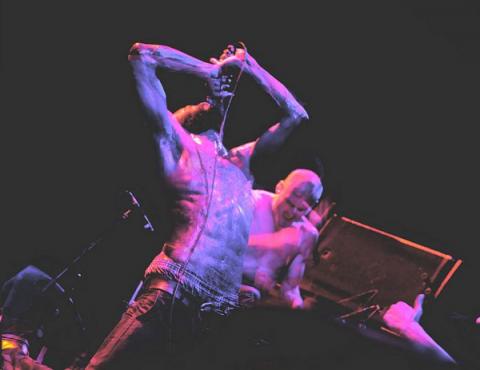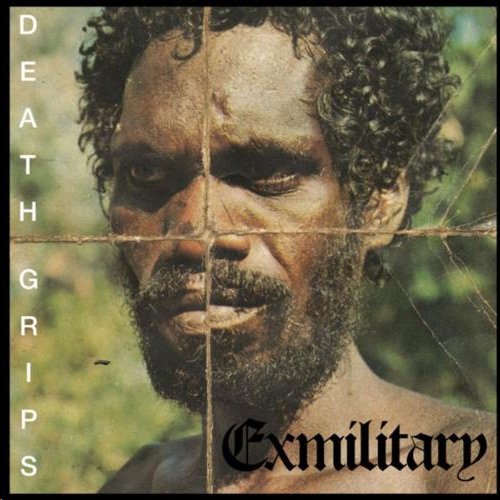Paying Homage to Punk and Hip-Hop, Death Grips Rebels Against the Mainstream

It’s not hard to find examples of “punk rock” in the mainstream. Levi’s used “Holiday in Cambodia,” the Dead Kennedys song about genocide in Indochina, to sell jeans, and if American teenagers are looking for garb that looks edgy, they don’t have to venture outside their local mall to find spiked bracelets and ripped jeans. Like so many rebellious movements, punk has become part of tradition. Of course, this wasn’t always the case. At its inception, punk rock was a radical phenomenon in youth culture that represented an authentic reaction to conformity and capitalist culture. There are still many sub-genres and groups that harness the rebelliousness and raw energy of punk in an original way. However, the rise of the Internet has made selling out an unavoidable fact. That’s not to say that you’re either a money-grubbing concubine or a demi-god of the alternative world whose artistic integrity shall be praised for eternity. Nevertheless, no matter how savvy marketing has become, youth culture continues to find authenticity through art.
One of the most radical components of punk music was its destruction of the superficial boundaries between white and non-white styles of music. Rock n’ roll was derivative of blues and jazz, but this influence, more often than not, was implicit. Punk exposed the connection. It doesn’t seem like a coincidence, then, that the rise of punk, in the late 1970s, only briefly preceded the rise of hip-hop in the early ‘80s. With the release of Nirvana’s Nevermind, 1991 is often referred to as “the year punk broke.” But unlike U.K. bands of the late ‘70s, and U.S. hardcore groups of the early ‘80s, Nirvana had enough hooks in their music and came along at the right time to make it big. Greil Marcus described the initial era of punk as a negation, as “the old critique of mass culture now paraded as mass culture, at least as protean, would-be mass culture.” Just like punk, hip-hop has been ingratiated into popular culture and, just like punk, the consequences of this are not so clear.
Punk broke at the beginning of the 90s in the US, a decade considered by many as the golden age of hip-hop. In the post-grunge era, during the mid-90s, hip-hop became a popular cultural fixture. Hybridizations of rock (which, generally, could be said to encompass punk) and hip/hop appeared, with groups like Limp Bizkit and Kid Rock selling millions. For white kids during the mid-80s, listening to hip-hop was a political statement.

After the death of Kurt Cobain, hip-hop was becoming a part of the fabric of American popular culture. Bakarari Kilwana observes, in his book Why White Kids Love Hip-Hop, how “the rarely disputed ‘fact’ that white suburban youth constitute hip-hop’s primary audience may now be as popular as hip-hop itself.” The past examples of white kids appropriating non-white musical forms- most notably rock n’ roll- has speculation that hip-hop may be headed down the same path. If suburban white kids’ love of hip-hop is divorced from the political, economic and social realities of many blacks, as Kilwana asserts, than their relationship to hip-hop, and, therefore, black youth culture, is merely reproducing the old racial politics. For the generations that have grown up in a post-segregation U.S. (the first being Generation X), hip-hop provides a glimpse into how institutional racism still persists. The correlations between punk and hip-hop may provide valuable insights into American identity, which is closely tied to race and, in youth culture, is constantly being re-imagined and recreated.
A new independent group, Death Grips, merges punk and hip-hop, amongst a kaleidoscope of other genres, creating tracks filled with boldness, impatience, licentiousness and jolts of unfettered creativity. But the group’s chaotic sound isn’t exactly hedonistic or apathetic; it is, at its core, a call to the audience to create themselves. If Sir Philip Sidney was resurrected, he would probably approve: for not only do they delight the audience, but they move the audience to action. It’s convenient to label the group as a punk band, or a radical, “experimental” hip-hop group, but neither label says much about them. Though there are allusions and sonic similarities to those genres, the band’s powerful sound comes from its unconventionality, from its willingness to destroy all the rules and create their own within a single track or their discography as a whole. Death Grips avoids the distorted, packaged versions of hip-hop and punk that the corporate music industry puts out. Drawing from the authentic aspects of each respective genre, amongst others, they have developed a sound that has shaken the independent music world.

Their music, in part, explores the correlations between punk and hip-hop, with a result that is, at once, haunting and invigorating. The group’s debut album, Exmilitary, starts with a sample of Charles Manson, the cult leader and murderer often associated with the dark side of 60s counterculture. The literary magazine N+1 held a panel in 2009 called, “What was the Hipster?: A Sociological Investigation.” During the panel, Christian Lorentzen references a friend of his who said that this generation’s counterculture hasn’t even produced a decent serial killer (alluding to Charles Manson).
Whatever defines the current American youth counterculture, though the ubiquity of the word ‘hipster’ seems related to it, Death Grips fits into it somewhere, as most, if not all, successful independent musicians do. Death Grips’ sample of Manson poses many questions to the current youth cultures of the U.S., a superpower in decline. Yet, this idea of the ‘hipster’, as Patrice Evans says, tends to overemphasize white youth culture: “If you’re talking about hipsters and want to get somewhere, you might be better off just talking hip-hop.” Maybe one of the biggest draws to Death Grips is that their music is not white. Arguing that a particular group has completely transcended racial boundaries could be as misleading as saying that institutional racism has been eliminated, but the ideas that Death Grips are playing with are about more than race.
Nabokov once wrote that it is childish to read a book in order to find something about its author. A novelist, one might argue, is different than a popular musician, but if any claims that popular culture can produce important art-- as opposed to Allan Bloom’s suggestion that it is all vile, masturbatory trash-- then musicians should not be endlessly and aimlessly talkedabout. The media hype surrounding the group reflects ugly realities about celebrity culture, diverting attention away from the music, from the art. The band’s scorn for the music industry in particular and Internet culture in general is refreshing. To a culture overly obsessed with Facebook likes and novelty, Death Grips shouts “f**k you,” not in order to negate, but to instigate.

The band signed to a major label, Epic, for their second LP, The Money Store. To no one’s surprise, they were dropped not long after the album’s release last year. A more extended stay on a major label would have provided an interesting foray into the corporate music industry for such an unconventional group. Yet the drop by Epic confirms that Death Grips is not suited for the mainstream. With such a visceral sound, the music is too schizophrenic to be blasted at a frat party. There’s a sense of humor to it, like in the absurdity of Manson’s words, “what am i gonna run around and act like i'm some teeny bopper somewhere for somebody else's money?”, but, ultimately, it’s too confrontational to be absorbed into mass culture. Overemphasizing the dark side of the music, which was a cliché often thrown around by music writers in the heyday of punk, however, takes away from the inspiring chaos that the music provides. Their use of a Black Flag sample, the definitive hardcore band of the 80s, who were, amongst others, the pioneers of the independent label in the U.S., is a fitting tip of the cap. On the cover of their latest, self-released album NO LOVE DEEP WEB, there is an erect penis, which added more fuel to the media hype surrounding the group. But unlike Odd Future, who use vulgarity to shock, Death Grips’ phallic imagery does not simply refer to itself; it is an extension of the their exploration of violence.
Kaya Oakes, in her book Slanted and Enchanted: The Rise of Indie Culture, observes that the importance of independent culture is the effects it has on the mainstream. If punk tore down the barriers between white youth culture and black youth culture, hip-hop was (and still is) the embodiment of black youth culture. Death Grips use punk (the music that used rock n’ roll against itself) to push their music further, reimagining hip-hop in the process. Punk, along with electronic and noise references, at the same time, deconstructs hip-hop itself, not to expose or to critique it, but to push it to another level. By synthesizing influences from punk, hip-hop, electronic and noise music, Death Grips explodes the crippling ideology of genre, rendering attempts to capture their sound in words impossible.
Author Bio:
John McGovern is a contributing writer at Highbrow Magazine.





























































































































































































































































































































